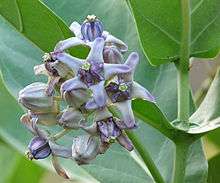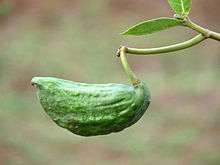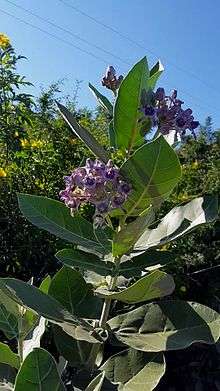Calotropis gigantea
| Calotropis gigantea | |
|---|---|
 | |
| Scientific classification | |
| Kingdom: | Plantae |
| (unranked): | Angiosperms |
| (unranked): | Eudicots |
| (unranked): | Asterids |
| Order: | Gentianales |
| Family: | Apocynaceae |
| Subfamily: | Asclepiadoideae |
| Genus: | Calotropis |
| Species: | C. gigantea |
| Binomial name | |
| Calotropis gigantea (L.) W.T.Aiton 1811 not (L.) R. Br. 1811 | |
| Synonyms[1] | |
| |


Calotropis gigantea (Crown flower) is a species of Calotropis native to Cambodia, Indonesia, Malaysia, Philippines, Thailand, Sri Lanka, India, China, Pakistan, Nepal, and tropical Africa.[2]
It is a large shrub growing to 4 m (13 ft) tall. It has clusters of waxy flowers that are either white or lavender in color. Each flower consists of five pointed petals and a small "crown" rising from the center which holds the stamens. The aestivation found in calotropis is valvate i.e. sepals or petals in a whorl just touch one another at the margin, without overlapping. The plant has oval, light green leaves and milky stem. The latex of Calotropis gigantea contains cardiac glycosides, fatty acids, and calcium oxalate.
Pollination
This plant plays host to a variety of insects and butterflies. It is the host plant for Hawaii's non-migratory monarch butterflies.[3] Calotropis is an example of entomophily pollination (pollination by insects) and pollination is achieved with the help of bees. In Calotropis, gynostegium is present (formed by the fusion of stigma and androecium). The pollen are arranged in a structure named pollinia which are attached to a glandular, adhesive disc at the stigmatic angle (Translator Mechanism). These sticky discs get attached to the legs of visiting bees so that pollinia are pulled out when the bee moves away. When such a bee visits another flower, this flower gets pollinated by the sticky pollinium.
Uses
The flowers last long, and in Thailand they are used in various floral arrangements. They were favored by the Hawaiian Queen Liliuokalani, who considered them a symbol of royalty and wore them strung into leis. While in Cambodia, they are used in funerals to decorate the urn or sarcophagus and the interior of the house holding the funeral. The fruit is a follicle and when dry, seed dispersal is by wind. In Indonesia its flowers are called widuri. According to Shivpuran (Hindu religion) Madar flower /Crown flower is very much liked by Lord Shiva therefore Crown flower and its graland is offered to Lord Shiva for peace,prosperity and stability in society.[4] Crown flower is also one of the major part of Nine Astrological Trees (Navagrah Tree) Crownflower cotton also used to make pillow which is very much healthy for headrest.
Calotropis yields a durable fiber (commercially known as Bowstring of India) useful for ropes, carpets, fishing nets, and sewing thread. Floss, obtained from seeds, is used for stuffing purposes. Fermented mixture of Calotropis and salt is used to remove the hair from goat skins for production of "nari leather" and of sheep skins to make leather which is much used for inexpensive book-binding.[5] Fungicidal and insecticidal properties of Calotropis have been reported.[6]
In India, the plant is common in the compounds of temples and is known as Madar in Hindi: मदार. Its leaf (Marathi: rui) is one of the five leaves used in the Panch Pallava, a ritual assortment of five different leaves used as a totem by the Maratha culture in India.[7]
It is known as වරා (waraa) in Sinhala, Aakonda in Bengali, Erukku (എരുക്ക്) in Malayalam and ark (अर्क) in Sanskrit.
Allelopathic effects
Allelopathic effects of Calotropis on different agricultural crops have been well studied.[8] Extracts of different plant parts such as root, stem, and leaf affect germination and seedling vigor of many agricultural crops.[9][10] However, extracts of Calotropis failed to produce any detrimental effects on weeds such as Chenopodium album, Melilotus alba, Melilotus indica, Sphaeranthus indicus, and Phalaris minor.[11]
Poisoning
Calotropis is a poisonous plant. The active principles are uscharin, calotoxin, calactin, and calotropin. The leaves and stem when incised yield thick milky juice. It is used as an arrow poison, cattle poison (see also Sutari), rarely for suicide and homicide and mostly an accidental poison.
The milky latex sap of Calotropis gigantea is a known cause of toxic keratoconjunctivitis and reversible vision loss. Crownflower keratitis is a rare condition and is usually the result of accidental ocular exposure to the sap. During the process of making a Hawaiian lei flower necklace, touching the sap and then touching the ocular surface may result in Crownflower keratitis. Damage (poisoning) of the cornea endothelium results in corneal stromal edema and decreased visual acuity. Although there is some permanent damage to the corneal endothelium with decreased endothelial cell count and irregular shape, the remaining corneal endothelial cells usually recover with complete resolution of the corneal edema and a return to normal visual acuity. The condition is usually self-limited and resolves faster with topical steroids. The clinical course of this condition suggests that Calotropis is paradoxically relatively nontoxic to corneal epithelium and highly toxic to corneal endothelium. The painless clinical course may be related to anesthetic properties of Calotropis latex and relatively minor epithelial injury.[12][13][14]
Signs and symptoms
Applied to the skin, it causes redness and vesication. When taken orally, the juice produces an acrid, bitter taste and burning pain in throat and stomach, salivation, stomatitis, vomiting, diarrhea, dilated pupils, tetanic convulsions, collapse and death. The fatal period is 6 to 12 hours. Treatment includes stomach wash, demulcents, and symptomatic treatment.
Mosquito controlling property
C. gigantea is reported to exhibit mosquito controlling properties against Culex gelidus and Culex tritaeniorhynchus mosquitoes which serves as vectors for Japanese encephalitis. The aqueous extract of the C. gigantea leaves demonstrated significant larvicidal, repellent and ovicidal activity.[15]
Literary references
In the Paushya chapter of the Adi Parva portion of the Indian epic Mahabharata, a disciple of the rishi Ayoda-Daumya named Upamanya goes blind by eating the leaves of the plant which in Sanskrit is called "Arka".
However, in India, among the general public, it is the belief that Akada (Arka) is a poisonous plant and can make people intoxicated. Lord Shiva is offered Akada along with Dhatura (extremely toxic) flowers on auspicious days.
References
| Wikimedia Commons has media related to Calotropis gigantea. |
- ↑ "The Plant List: A Working List of All Plant Species". Retrieved 11 July 2014.
- ↑ Bingtao Li; Michael G. Gilbert; W. Douglas Stevens, "Calotropis gigantea (Linnaeus) W. T. Aiton, Hortus Kew. ed. 2. 2: 78. 1811", Flora of China online, retrieved 19 July 2015
- ↑ Butterfly Society of Hawaii
- ↑ http://www.freepressjournal.in/weekend/mahashivaratri-favorite-plants-of-lord-shiva/798182
- ↑ Singh et al. 1996
- ↑ Ganapathy and Narayanasamy 1993
- ↑ Indian Trees
- ↑ Oudhia, P. (2002).Allelopathic potential of useful weed Calotropis gigantea R.Br: A review. In: Abstracts. Third World Congress on Allelopathy: Challenges for the New Millennium, National Institute for Agro-Environmental Sciences (NIAES), Tsukuba, Japan, Aug.26-30,2002:179.
- ↑ Oudhia and Tripathi 1997, 1999
- ↑ Oudhia et al. 1997, 1998a,b
- ↑ Oudhia and Tripathi 1997
- ↑ Wong, W. H.: Crownflower keratoconjunctivitis, Hawaii Med J. 1949;8:339-341.
- ↑ Crawford, H. E. : Crownflower Keratoconjunctivitis, Hawaii Med J. 1958;17:244-245
- ↑ Hani S. Al-Mezaine, Ali A. Al-Rajhi, Abdullah Al-Assiri, Michael D. Wagoner, Calotropis procera (ushaar) keratitis, American Journal of Ophthalmology, Volume 139, Issue 1, January 2005, Pages 199-202
- ↑ Kumar G, Karthik L, Rao KVB, Karti AV, Rahuman AA, Larvicidal, Repellent and Ovicidal activity of Calotropis gigentia against Culex tritaeniorhynchus and Culex gelidus. Journal of Agricultural Technology, 2012, 8(3): 869-880
External links
- PIER - Calotropis gigantea
- Flowers of India - Crown flower
- Purdue University: Center for New Crops & Plant Products - Crown flower
- Dressler, S.; Schmidt, M. & Zizka, G. (2014). [http://www.africanplants.senckenberg.de/root/index.php?submitForm=true&page_id=77&searchTextMenue=Calotropis+gigantea&filterRegionIDs[]=6&filterRegionIDs[]=1&filterRegionIDs[]=2&filterRegionIDs[]=3&filterRegionIDs[]=5 "Calotropis gigantea"]. African plants – a Photo Guide. Frankfurt/Main: Forschungsinstitut Senckenberg.